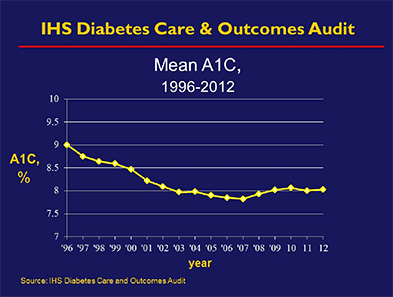DIABETES
ISSUE
American Indians and Alaska Natives (AI/AN) have the highest rates of type 2 diabetes in the United States. Once exclusively a disease of adults, type 2 diabetes is increasingly common among AI/AN youth, threatening the health, well-being, and quality of life of future generations. Diabetes prevention efforts are an urgent priority, as well as diabetes management to prevent complications.
BACKGROUND
For three decades, the IHS has served as a leader in the fight against the diabetes epidemic in AI/AN communities, earning national and international recognition for diabetes quality improvement. Major accomplishments include developing monitoring systems of diabetes clinical care, such as the annual IHS Diabetes Care and Outcomes Audit, and creating diabetes surveillance systems for tracking diabetes prevalence and complications. The IHS Division of Diabetes Treatment and Prevention (DDTP) has also developed and mobilized an extensive network to conduct diabetes treatment and prevention programs and activities throughout the Indian health system. Given the limited resources available for diabetes care, the IHS focuses on applying scientifically proven methods to prevent the onset of diabetes and costly diabetes-related complications such as cardiovascular, eye, nerve, and kidney disease.
STATUS
In the Balanced Budget Act of 1997, Congress established the Special Diabetes Program for Indians (SDPI) and provided $150 million over 5 years for “the prevention and treatment of diabetes in American Indians and Alaska Natives.” Funds have been reauthorized at $150 million per year through fiscal year 2013.
The major components of the SDPI are administered by the IHS DDTP. There are 336 community-directed diabetes programs in 35 states that implement diabetes treatment and prevention programs based on scientifically proven Best Practices. These programs are designed to address local community priorities. Another 66 SDPI Demonstration Projects successfully completed a 6-year program translating the results of diabetes prevention and cardiovascular disease risk reduction research into diverse, real world Indian health settings. As a result of their work, we now know that it is possible to reduce risk factors for diabetes and cardiovascular disease in AI/AN communities. These programs are continuing their prevention efforts as well as working on toolkits to help disseminate their positive results, best practices, and lessons learned throughout Indian country.

Diabetes health outcomes have improved significantly in AI/AN communities since the inception of the SDPI. One of the most important improvements is a 10.8 percent decrease in the mean blood sugar level (A1C) of AI/ANs with diagnosed diabetes (see chart), a major achievement over 16 years. Decreases of this magnitude translate to an almost 40 percent reduction in diabetes-related complications.
OPTIONS/PLANS
The IHS continues to strengthen its diabetes infrastructure at the Headquarters and Area office levels to maintain and improve diabetes surveillance, technical assistance, provider networks, and clinical monitoring, as well as promoting culturally sensitive prevention and treatment programs.
ADDITIONAL INFORMATION
For referral to the appropriate spokesperson, contact the IHS Public Affairs Staff at 301-443-3595.
January 2013
Download this fact sheet [PDF - 58KB]
